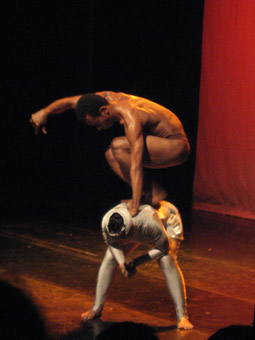 |
Merah photo Phalla San |
The dancers are only very slightly illuminated by a smattering of light on the cyclorama that simulates moonlight shining through thick leafy branches. Because we had been in the darkness so long, I was not even sure if the second dancer, situated in an upstage corner, was indeed actually there; he seemed to blend into the cyclorama so much that my still-adjusting eyes were convinced that he was merely an image projected on the screen.
The other dancer, whom we later discover is Merah’s choreographer, Asri Mery Sidowati, stands at the opposite corner, nearer the audience. She is covered head to ankle in a shiny, metallic body suit. In contrast, the dancer upstage, who is not a hologram after all, is stripped down to the briefest of briefs. As he jaggedly moves to the sound of crickets and birds rustling through the night, it becomes obvious that he is meant to be of the earth—a primal version of man—while the figure wrapped in metallic cloth, who very slowly yet continuously moves her cradling arms in patterns around her body, might very possibly be otherworldly, a spirit but also possibly an alien. Given the costuming and my lack of knowledge of Indonesian mythology, it is difficult to determine which.
The male dancer has the more interesting movements: flexing and undulating, posturing sporadically in between, darting, flicking his fingers, shoulders and head almost as if in reaction to the sudden chirp of a cricket. After an eternity of this minimal movement from both figures, they edge towards one another, until they stand side by side with their feet wide apart. Together, they pull their heads back into a circular sweep, the man with his back to the audience, shoulders rippling with muscles as he does. Shortly after, they enter a common sphere, the man reaching for the wrapped figure and slowly wrapping himself around her midsection so they become one—an image sustained a little too long but allowing time for speculation. The man is not afraid of this otherworldly being, who, in return, readily accommodates him. After the performance, I overhear that she represents Mother Earth, but this didn’t occur to me at all since she moved into his space, merely visiting the world that he inhabited.
I see her instead as an external entity, and the male figure's act of attaching himself to her as an exercise in empowerment, a kind of calling upon divine forces for strength. He climbs up on her back and is immediately garbed in a mirrored vest—a triumphant acquisition of power, exhilarating and uplifting, the glass shards flashing light over stage and audience. This invocation of a deity ends in triumph and frees man from the overwhelming, suffocating darkness with which the work began.
Later, however, I read the program notes and am entirely confused. It seems that Asri choreographed Merah as a commentary on Global Warming; the correct reading of the work would then be that grasping Mother Earth and stepping on her would be some form of abuse that she endures and even allows. The mirrored vest can then be read as an explosion of sorts—if we step on Mother Earth, we must be ready for the consequences. However, the work did not translate this threat clearly and, as I've pointed out, the tone of the ending was more inspiring than ominous.
Audiences may take whatever they wish from a particular work, and whether Asri likes it or not, her message will not always come across as intended. I applaud Merah's journey from darkness to light, from gloom to triumph, and the slow, measured, unremitting pace that it took to get there.
Indonesian Dance Festival 2010: Merah, choreographer Asri Mery Sidowati, performers Asri Mery Sidowati, Serraimere Boogie Y Koirewoa, music Arif Susanto, sound Teuku Rifnu Wikana, costumes Ling Ling; Teater Luwes, Jakarta, June 15
Joelle Jacinto is a dance critic and scholar in the Philippines. She is the editor-in-chief of Runthru, a bi-annual dance magazine, and its accompanying website. She wrote for Malaya (daily broadsheet) for seven years, and has contributed to several publications and writes currently for Goethe Institut’s Tanzconnexions website. She also dances for Philippine Ballet Theatre and TEAM Dance Studio, and has an MA in Art Theory and Criticism.
© Joelle Jacinto; for permission to reproduce apply to [email protected]








 back
back